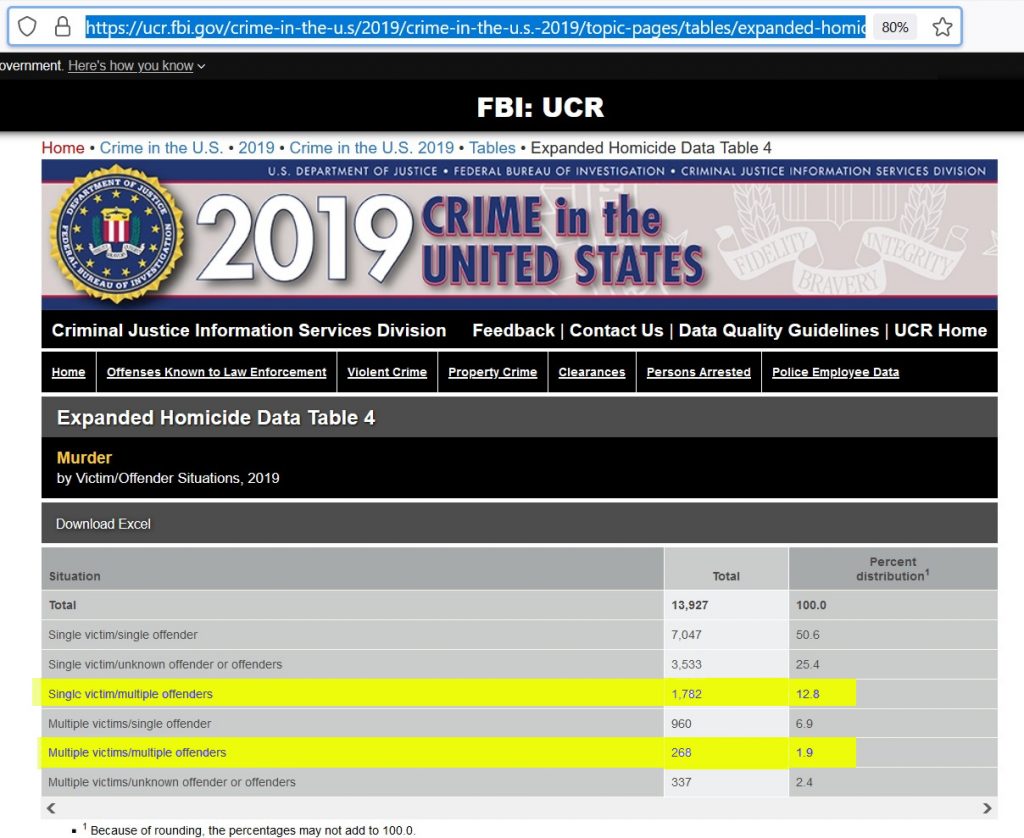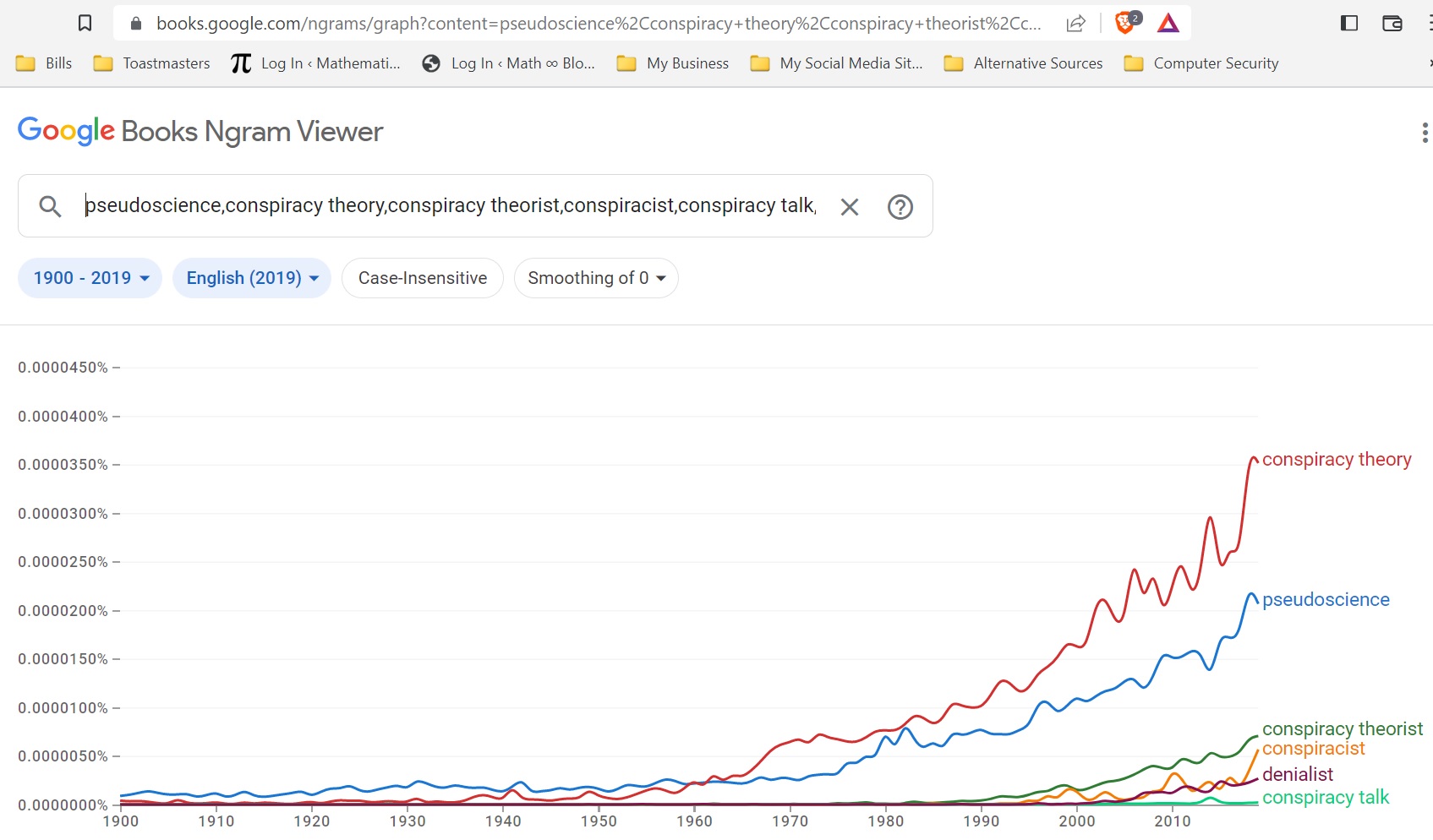Introduction
“Conspiracy theory” is now a shorthand for crazy, irrational conspiracy theory from a nut or nuts used to quickly dismiss all sorts of ideas including even objective facts, generally applied when the “conspiracy theory” suggests misconduct or error by authority figures in a group the “conspiracy theory” labeler identifies strongly with.
“Conspiracy theory” has broadened to included related phrases: “conspiracy theorist,” “conspiracist”, “conspiracy thinking,” and even just “conspiracy.” In recent decades it is increasingly bundled with other thought stopping pejorative phrases such as “witch hunt,” “pseudoscience,” “denialist”, or “denier”.

The shorthand pejorative meaning of “conspiracy theory” has expanded to include error theories that do not propose an actual conspiracy such as a laboratory leak of SARS-COV-2 at the Wuhan Institute of Virology and been used by high government officials such as Anthony Fauci and associates to stigmatize suggestions they may have made significant errors. “Conspiracy theory” has been frequently applied to the Mandela Effect and Graham Hancock’s lost civilization theories, recently expounded in the Netflix Ancient Apocalypse docuseries even though neither proposes a conspiracy.
This pejorative meaning of “conspiracy theory” represents a change in common usage of English that makes it difficult to either discuss or think about possible misconduct or error by groups of people, especially groups of powerful people. In this it resembles George Orwell’s fictional Newspeak in his novel 1984, a simplified English in which it is impossible to express or imagine error or misconduct by the ruling political party.
How, in fact, should we react when someone, especially authorities and experts shout “conspiracy theory” or “conspiracy theorist,” to dismiss something out of hand? Clearly one should not rely on pejorative labels such as “witch hunt,” “conspiracy theory,” “denialism,” or “pseudoscience” to dismiss alleged facts or actual conspiracy theories in the non-pejorative legal sense out of hand.
This does not depend on whether these labels were generated or centrally directed by the CIA, the Lyndon Johnson White House, the CPUSA, or any other group or real conspiracy. One needs to look at the actual facts and logic so labeled.
“Conspiracy theory,” “conspiracy theorist,” and other related pejorative labels are frequently used as if to say: criminal conspiracies are essentially impossible or so rare as to be easily and quickly dismissed by any sane rational person. One in a thousand. One in a million. Even physically impossible.
The pejorative “conspiracy theory” or related labels are generally applied to theories about significant events. These events are most often assassinations, murders, or suspected murders such as the assassination of President John F. Kennedy, his brother Robert Kennedy, Martin Luther King, Malcolm X, the alleged suicide of late “financier” Jeffrey Epstein and others, where the alleged or suspected conspirators are usually authority figures in the group or groups the “conspiracy theory” labeler identifies strongly with.
| Event | Date(s) | Killed | Official Cause |
| Assassination of Senator Huey Long | Sep. 10, 1935 | Huey Long, Carl Weiss | Carl Weiss acting alone, Weiss killed by Long’s bodyguards |
| JFK Assassination | Nov 22, 1963 | John F. Kennedy, J.D. Tippit, Lee Harvey Oswald | Lee Harvey Oswald acting alone. Oswald killed by Jack Ruby acting alone. |
| Malcolm X Assassination | February 21, 1965 | Malcolm X (born Malcolm Little) | Originally convicted: Muhammad A. Aziz (exonerated) Khalil Islam (exonerated) Thomas Hagan Conspiracy by enemies in the Nation of Islam. |
| MLK Assassination | April 4, 1968 | Martin Luther King | James Early Ray acting alone |
| RFK Assassination | June 5, 1968 | Robert Francis Kennedy | Sirhan Sirhan acting alone |
| Oklahoma City Bombing | April 19, 1995 | at least 168 people | Timothy McVeigh, Terry Nichols (Michael Fortier convicted of related offenses, but not the conspiracy, plea deal) |
| TWA Flight 800 | July 17, 1996 | 230, all on board | accidentally blew up |
| September 11 Attacks | September 11, 2001 | 2,996 | attributed to 19 hijackers acting on orders from Osama bin Laden |
| Anthrax attacks | September 18 – October 12, 2001 | 5 killed | Eventually blamed on researcher Bruce Ivins |
| Jeffrey Epstein “suicide” | August 10, 2019 | 1 dead | Ruled a suicide |
| COVID-19 Pandemic | Fall 2019 – Present | Several million worldwide | Unknown |
“Conspiracy theory” labelers frequently use superficially plausible arguments backed up by no data or a single or few examples. For example, conspiracies will always or almost always fail because someone would have talked, citing for example the exposure of the Watergate burglary failure and the downfall of Richard Nixon. This would for example suggest unsolved murders by conspiracies, such as “gang” murders, “Mafia” or “organized crime” murders, or Provisional IRA murders in Northern Ireland are exceptionally rare or nonexistent (see data below).
Conspiracy Data
There are laws against criminal conspiracy and people are convicted under these laws all the time. The FBI statistics on homicides for 2019 shows that about 14.7% of “cleared” (ostensibly solved) murders in 2019 involved at least one accomplice, a conspiracy in common usage.

A review of Wikipedia’s list of US serial killers showed that 56 of 553 identified serial killers active from 1950 to 2020 had accomplices, a conspiracy in common usage. This is 10.13% of the names listed. The error is roughly 1.4% giving a ninety-five percent confidence interval of about 7.9% to 13.2% of identified serial killer cases involve conspiracies — have accomplices. This provides a check on the FBI official numbers where the names of the killers and victims or at least forensic evidence of victims who could not be identified in some cases are available for independent review.
A review of US Presidential assassinations and plots showed that at least one of the four Presidential Assassinations (Lincoln) was clearly a conspiracy and 9-10 of 37 failed Presidential assassination attempts were conspiracies of some sort.
Unsolved Murders in United States
The FBI listed 27.8% of homicides in 2019 with an unknown offender or offenders. The rate of unsolved murders in the United States has increased substantially since the early 1960s. Police and other law enforcement officials in the United States often attribute unsolved murders to gang violence. Gangs are conspiracies in common English usage.
There is significant controversy over the fraction of unsolved murders due to gang violence. The FBI’s Supplemental Homicide Reports (SHR) generally list about 7.4 percent of unsolved homicides as gang related (categories “Gangland killing” and “Juvenile gang killings”). This usually appears to be based on the victim or victims being known to law enforcement as gang members. A survey of Wikipedia’s lists of unsolved murders both in the United States and around the world, found sixty-eight (68) out of 820 unsolved murder cases (8.29%) with notes indicating a suspected “gang,” “mafia,” or “organized crime” murder.
US CIA Murders
The US CIA declassified evidence in the 1970s strongly suggesting their involvement in the assassinations/deaths of Patrice Lumumba in the Belgian Congo (later Zaire), Dominican Republic dictator Rafael Trujillo and his son, President of South Vietnam Ngo Dinh Diem and his brother, Salvador Allende in Chile, and unsuccessful plots to kill Cuban President Fidel Castro in league with the US Mafia.
The CIA also declassified some records in the 1970s of a series of mind control research programs, usually referred to popularly as MK-ULTRA, involving many prominent scientists (Martin Orne, Louis Jolyon West, Ewan Cameron, many others) and illegal experiments on uninformed test subjects and even children. The mind control programs were kept secret for about twenty years and much remains unknown about these programs. At least one participant, CIA officer Frank Olson fell, jumped, or was thrown to his death nine days after being surreptitiously dosed with LSD.
Unsolved Murders in Northern Ireland
The Police Service of Northern Ireland (PSNI) has at least 1,186 unsolved murders from the so-called “Troubles,” civil conflict involving organized paramilitaries such as the Provisional IRA and the Ulster Defense Force (UDF), the Royal Ulster Constabulary (RUC) (police, now the PSNI), the British Army and possibly intelligence related groups from the UK. This is out of about 3,200 murders from January 1969 to the signing of the “Good Friday” agreement on April 10 1998 — considered the period of the “Troubles.”
Of the 1,186 killings that the PSNI’s Legacy
Investigation Branch is assessing:
- 45.5% are attributed to republican
paramilitaries. (loosely Irish Catholics, Communist
groups) - 23% are attributed to loyalist paramilitaries.
(loosely English and Ulster Scots Protestants) - 28.5% are
attributed to the security forces. (loosely the UK British troops and
intelligence groups) - For the remaining 3% of deaths, the
background of those primarily responsible is unknown.
These represent still unsolved murders mostly attributed to large scale conspiratorial organizations. As with alleged unsolved gang related killings in the United States, proof is elusive. The politically charged 1972 disappearance/murder of Jean McConville, alleged to have been ordered by the Sinn Fein political party leader Gerry Adams in transcripts of “oral histories” collected by Boston College (USA) from former IRA members who claimed to have abducted and shot Jean McConville, has never been officially solved, although her body was discovered in 2004. Adams denies ever having been in the IRA, let alone being one of its leaders, or ordering the murder. (See, for example, Say Nothing: A True Story of Murder and Memory in Northern Ireland by Patrick Radden Keefe)
Unsolved Murders in Other Civil Conflicts
The conspiratorial civil conflict in Northern Ireland is unusual in taking place in a “first world,” western European “democracy.” Somewhat similar conflicts have occurred in many other nations with secretive revolutionary, quasi-governmental and governmental groups contending for power. Everything from the total number killed, number of unsolved murders, who killed whom and why, what constituted legitimate warfare versus war crimes is disputed. These include El Salvador’s civil war (1980-1992), Argentina’s “dirty war” in the 1970s and 1980s, civil conflict and war in the former Yugoslavia in the 1990s, civil conflict in South Africa in the 1980’s and early 1990s.
Arguably entire nations have devolved into criminal conspiracies with no rule of law, extensive secrecy and government lying to the population, and large numbers of executions including Nazi Germany, the Stalinist Soviet Union and China during the Great Leap Forward and the Cultural Revolution.
Conclusion
It is clearly rational to suspect conspiracies including high level conspiracies in unsolved or suspicious “solved” murders. The likelihood of a conspiracy involved in an unsolved murder is probably at least 8%, simply using the fraction of unsolved murders where a “gang” or “mafia” is officially suspected by law enforcement.
(C) 2023 by John F. McGowan, Ph.D.
About Me
John F. McGowan, Ph.D. solves problems using mathematics and mathematical software, including developing gesture recognition for touch devices, video compression and speech recognition technologies. He has extensive experience developing software in C, C++, MATLAB, Python, Visual Basic and many other programming languages. He has been a Visiting Scholar at HP Labs developing computer vision algorithms and software for mobile devices. He has worked as a contractor at NASA Ames Research Center involved in the research and development of image and video processing algorithms and technology. He has published articles on the origin and evolution of life, the exploration of Mars (anticipating the discovery of methane on Mars), and cheap access to space. He has a Ph.D. in physics from the University of Illinois at Urbana-Champaign and a B.S. in physics from the California Institute of Technology (Caltech).

